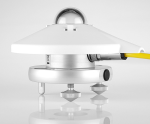This product is not available for new orders.

| Services Available |
|---|
Overview
The CMP6, manufactured by Kipp & Zonen, is an ISO first-class pyranometer that monitors solar radiation for the full solar spectrum range. It connects directly to a Campbell Scientific datalogger and is commonly used for environmental monitoring, solar resource assessment, and solar power performance applications.
Read MoreBenefits and Features
- Double glass dome and increased thermal mass improve performance, allowing it to have an ISO first-class classification
- Compatible with most Campbell Scientific data loggers
- Integrated bubble level is visible without removing sun shield
- Desiccant-filled drying cartridge prevents dew from forming on the inner sides of the domes
- Compatible with the CVF4 heater/ventilator that keeps the domes free from ice and dew
- Measures reflected solar radiation when inverted
- Provides measurements in direct sunlight, under plant canopies, when the sky is cloudy, and in artificial light
- Compatible with the CWS900-series interfaces, allowing it to be used in a wireless sensor network
Images








Similar Products
Detailed Description
The CMP6 measures solar radiation with a high-quality blackened thermopile protected by two glass domes. Its flat spectral sensitivity, from 285 to 2800 nm, makes it ideal for applications in natural sunlight, under plant canopies, in green houses or buildings, and inverted to measure reflected solar radiation.
A desiccant-filled drying cartridge prevents dew from forming on the inner sides of the CMP6's domes. Campbell Scientific also offers the CVF4 heater/ventilator that keeps its domes free from ice and dew.
The CMP6 includes a white snap-on sun shield that reduces the sensor's temperature. A bubble level and adjusting leveling screws enable the sensor to be leveled without using a leveling base.
The CMP6 produces a millivolt signal that is measured directly by a Campbell Scientific datalogger.
Compatibility
Note: The following shows notable compatibility information. It is not a comprehensive list of all compatible or incompatible products.
Dataloggers
| Product | Compatible | Note |
|---|---|---|
| CR1000 (retired) | ||
| CR1000X (retired) | ||
| CR300 (retired) | ||
| CR3000 (retired) | ||
| CR310 | ||
| CR350 | ||
| CR6 | ||
| CR800 (retired) | ||
| CR850 (retired) |
Additional Compatibility Information
Mounting
The CMP6 has a bubble level and two leveling feet, which allow it to be leveled without using a leveling base. This pyranometer mounts to a mast, crossarm, or pole (1.0 in. to 2.1 in. OD) via the CM255 or CM255LS mounting stand. The CMP6 should be mounted away from all obstructions and reflective surfaces that might adversely effect the measurement.
Specifications
| Sensor | High-quality blackened thermopile protected by two glass domes |
| Measurement Description | Monitors solar radiation for the full solar spectrum range |
| ISO Classification | Class B (first class) |
| Spectral Range | 285 to 2800 nm |
| Sensitivity | 5 to 20 μV W-1 m2 |
| Temperature Dependence of Sensitivity | < 4% (-10° to +40°C) |
| Response Time | < 18 s (95% of final value) |
| Zero Offset Due to Thermal Radiation | < 15 W/m2 (200 W/m2) |
| Non-Stability | < 1% (change/year) |
| Non-Linearity | < 1% (0 to 1000 W/m2) |
| Directional Error | < 20 W/m2 (up to 80° with 1000 W/m2 beam) |
| Tilt Error | < 1% |
| Level Accuracy | 0.1° |
| Impedance | 20 to 200 Ω |
| Operating Temperature Range | -40° to +80°C |
| Typical Signal Output | 0 to 20 mV (for atmospheric applications) |
| Maximum Irradiance | 2000 W/m2 |
| Expected Daily Uncertainty | < 5% |
| Dome Diameter | 5 cm (2 in.) |
| Width | 15 cm (5.9 in.) with shield |
| Height | 9.25 cm (3.64 in.) |
| Weight | 0.9 kg (2 lb) with 10.1 m (33 ft) cable |
Frequently Asked Questions
Number of FAQs related to CMP6-L: 5
Expand AllCollapse All
-
The ISO and WMO classify First Class pyranometers, such as the CMP6-L, as suitable for network operations. However, if accuracy is of paramount concern, consider using Class A pyranometers, such as the CMP11-L and CMP21-L, instead.
-
No. These are all passive devices that create their own voltage signal as a response to the measurement being made. There is, however, a heater and ventilator for these sensors (CVF4) that requires a power supply.
-
All of these pyranometers measure the amount of solar short-wave radiation incident on a surface. Because of their accuracy and performance level, the CMP11 and CMP21 are classified by the International Organization for Standardization (ISO) and World Meteorological Organization (WMO) as Secondary Standard sensors, representing the highest level of measurements made by pyranometers. In comparison, the CMP6 is classified as a First Class sensor, which is the middle classification for pyranometers. (Second Class is the lowest pyranometer classification.)
-
Because of the loss of IR radiation, nearly all thermopile instruments typically have a negative offset. This offset is most easily visible at night-time, when a small negative value is read instead of zero. This same offset is present during the daytime, but it is not as visible because of the large solar signal.
Another common issue involves leveling an instrument. Leveling a thermopile instrument can cause errors in the direct beam component because the cosine response is not correct. These errors are more notable when the sun is close to the horizon because the angle is so shallow.
-
To incorporate a sensor that is compatible with wireless sensor interfaces into a wireless network, a CWS900-series wireless sensor interface is needed, as well as an A205 CWS-to-PC interface to configure it.

